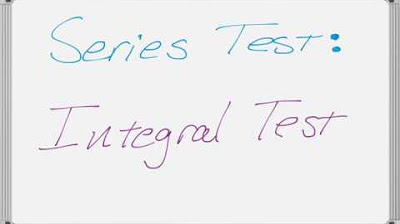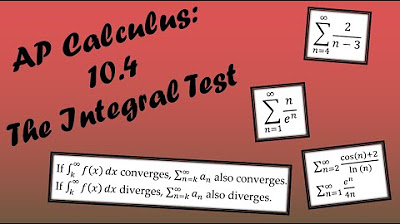Worked example: Integral test | Series | AP Calculus BC | Khan Academy
TLDRThe video script explains the Integral Test for determining the convergence of infinite series. It demonstrates how if a continuous, decreasing function's improper integral from k to infinity converges, the corresponding series also converges. Conversely, if the integral diverges, the series does as well. Examples using 1/n^2 and 1/n are provided to illustrate the test's application.
Takeaways
- 📚 The Integral Test is a formal method to determine the convergence of an infinite series where the function is positive, continuous, and decreasing over an interval from a certain point to infinity.
- 🔍 If the improper integral from a point 'k' to infinity of a function 'f(x)' is convergent, then the infinite series from 'n=k' to infinity of 'f(n)' is also convergent.
- 🔄 Conversely, if the improper integral from 'k' to infinity of 'f(x)' is divergent, then the corresponding infinite series is also divergent.
- 📈 The test was exemplified with '1/n^2', where the integral from 1 to infinity is convergent and equals one, indicating the series also converges.
- 📉 An example of divergence was given with '1/x', where the integral from 1 to infinity diverges, implying the series also diverges, specifically the harmonic series.
- 📝 The function 'f(x) = 1/x' meets the criteria for the Integral Test: it is positive, continuous, and decreasing from 1 to infinity.
- 🧩 The improper integral of '1/x' from 1 to infinity is calculated as the limit of the natural log function, which approaches infinity, indicating divergence.
- 📊 The Integral Test's logic is akin to comparing the area under the curve of 'f(x)' to the sum of rectangles that overestimate this area, suggesting that if the integral diverges, so does the series.
- 📚 The motivation behind the Integral Test is to use the area under the curve as a visual and intuitive way to understand the behavior of an infinite series.
- 📐 The test is particularly useful for series where the terms are related to the derivative of a function, allowing for a graphical interpretation of convergence or divergence.
- 📘 The script provides a clear demonstration of how to apply the Integral Test to both convergent and divergent series, offering a practical understanding of the concept.
Q & A
What is the Integral Test?
-The Integral Test is a method used to determine the convergence or divergence of an infinite series. It states that if a function f(x) is positive, continuous, and decreasing on an interval starting from k to infinity, then the convergence of the improper integral from k to infinity of f(x) dx implies the convergence of the infinite series from n=k to infinity of f(n), and vice versa.
What are the conditions for applying the Integral Test?
-The Integral Test can be applied if the function f(x) is positive, continuous, and decreasing on the interval from k to infinity.
How does the Integral Test relate to the convergence of an infinite series?
-If the improper integral from k to infinity of f(x) dx is convergent, then the infinite series from n=k to infinity of f(n) is also convergent. Conversely, if the integral is divergent, the series is also divergent.
What is an example of a function where the Integral Test shows the series is convergent?
-An example is when f(x) = 1/x^2. The improper integral from 1 to infinity of 1/x^2 dx is convergent (equal to 1), thus the series from n=1 to infinity of 1/n^2 is also convergent.
What is the harmonic series and why is it divergent?
-The harmonic series is the infinite series from n=1 to infinity of 1/n. It is divergent because, as shown by the Integral Test, the improper integral from 1 to infinity of 1/x dx is unbounded, indicating that the series also diverges.
How does the Integral Test use the concept of an improper integral?
-The Integral Test compares the improper integral from k to infinity of f(x) dx with the sum of the infinite series from n=k to infinity of f(n). The behavior of the integral (convergent or divergent) directly determines the behavior of the series.
What is the antiderivative of 1/x used in the script?
-The antiderivative of 1/x with respect to x is the natural logarithm of x, ln(x).
How does the script demonstrate the divergence of the harmonic series using the Integral Test?
-The script shows that the improper integral from 1 to infinity of 1/x dx diverges by evaluating it as the limit of ln(t) as t approaches infinity, which is unbounded. Since the integral diverges, the harmonic series also diverges.
What is the significance of the function f(x) = 1/x in the context of the Integral Test?
-The function f(x) = 1/x is used to illustrate the application of the Integral Test. It meets the criteria of being positive, continuous, and decreasing from 1 to infinity, allowing the test to be applied to determine the divergence of the corresponding series.
How does the script use the concept of a Riemann sum to explain the Integral Test?
-The script suggests viewing the sum of the series as a left-sided Riemann sum, where each term of the series represents the area of a rectangular block. This visual aids in understanding why the series diverges if the corresponding integral diverges.
Outlines
📚 Introduction to the Integral Test
This paragraph introduces the Integral Test, a method for determining the convergence of an infinite series. It explains that if a positive, continuous, and decreasing function's improper integral from a starting point k to infinity is convergent, then the corresponding infinite series is also convergent. Conversely, if the integral is divergent, the series is likewise divergent. The explanation uses the example of the series 1/n^2 and 1/n to illustrate the test's application, highlighting the integral's role in assessing convergence.
🔍 Applying the Integral Test to the Harmonic Series
The second paragraph delves into applying the Integral Test to the harmonic series, which is the sum of the reciprocals of the natural numbers. It demonstrates that the improper integral of 1/x from 1 to infinity is divergent, implying that the harmonic series is also divergent. The explanation includes a step-by-step calculation of the integral and uses a visual representation to show how the series' partial sums overestimate the area under the curve, leading to the conclusion of divergence. The paragraph reinforces the intuition behind the Integral Test and its utility in series convergence analysis.
Mindmap
Keywords
💡Integral Test
💡Convergent
💡Divergent
💡Improper Integral
💡Continuous
💡Decreasing
💡Harmonic Series
💡Natural Logarithm
💡Riemann Sum
💡Oresme
💡Convergence Criteria
Highlights
Introduction to the Integral Test for infinite series convergence.
Assumption of a positive, continuous, and decreasing function for the Integral Test.
Statement that if the improper integral from k to infinity is convergent, the infinite series is also convergent.
Conversely, if the improper integral is divergent, the corresponding infinite series is also divergent.
Example of one over n squared, where the integral is convergent and equals one.
Application of the Integral Test to the harmonic series, showing its divergence.
Explanation of the integral from one to infinity of one over x, which meets the test's conditions.
Calculation of the improper integral of one over x, showing it is unbounded and divergent.
The conclusion that the harmonic series is divergent, supported by the Integral Test.
Illustration of the function f(x) = 1/x and its properties over the interval from one to infinity.
Visual representation of the function and its relation to the area under the curve.
Comparison of the area under the curve to the sum of the series, indicating the series' divergence.
The Integral Test's motivation and its relation to left-sided Riemann sums.
Explanation of how the series' terms overestimate the area under the curve.
Final conclusion that if the improper integral is divergent, the series must also diverge.
The elegance and practicality of the Integral Test in determining series convergence.
Transcripts
Browse More Related Video

The Comparison Theorem for Improper Integrals | Step by Step Explanation | Math with Professor V

Proof of p-series convergence criteria | Series | AP Calculus BC | Khan Academy

Series Tests - The Integral Test

AP Calculus BC Lesson 10.4

The Root Test

Improper Integrals - Convergence and Divergence - Calculus 2
5.0 / 5 (0 votes)
Thanks for rating: